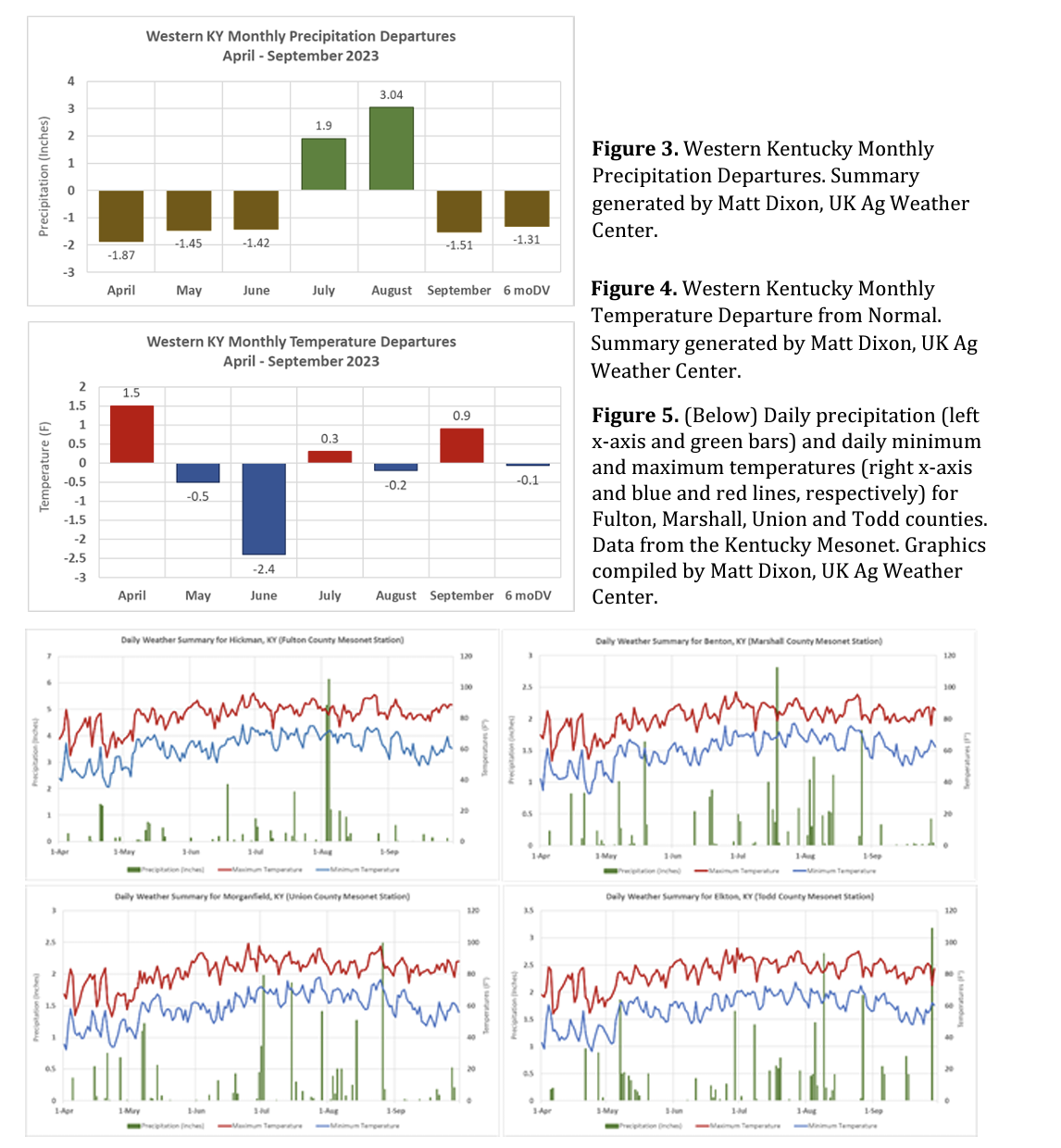Excellent Corn and Soybean Yields Despite Low Rainfall Totals
Both corn and soybean finished strong across Kentucky despite lower total rainfall amounts across most of the state. The 2023 Kentucky corn crop is estimated by the Kentucky Office of the United States Department of Agriculture National Agricultural Statistics Service (USDA-NASS) at 183 bushels per acre, up 17% from 2022, making the second largest corn crop on record. The 2023 Kentucky soybean crop is estimated by USDA-NASS at 55 bushels per acre, a 7.8% increase from 2022. Yet, the Kentucky rainfall totals are below normal from April to September 2023 across most of the state (Figures 1 and 3).
Corn in Kentucky often experiences peak water demand in July while soybeans often need most water in July or August. On average across the state and in western Kentucky, rainfall was above average for those two months. The higher rainfall in April made planting a challenge but started off the season with excellent soil moisture. While temperatures from April to September averaged near normal to below normal for most of the state (Figures 2 and 4), they were below normal for April, May, and June, which caused the crops to demand less water. Both temperatures and rainfall increased to above normal in western Kentucky during July when corn needed water the most. August, historically the warmest month in Kentucky, experienced slightly cooler temperatures on average, allowing crops to stretch the seed filling period a little longer in many fields. For most of the state, these weather patterns were favorable for excellent crop production.
These first set of graphs do not tell the complete story and rainfall totals can be misleading sometimes. Fulton County received 30.54 inches of rain from April 1 to September 30, 2023, suggesting more than adequate rainfall (Figure 5). By comparison Union County, Marshall County and Todd County received 20.62 inches, 23.11 inches and 28.5 inches, respectively. These numbers suggest that Fulton County experienced the best growing conditions. However, Fulton County was hit with over 12 inches of rain in 3 days in early August. Receiving 40% of the total rainfall in 3 days is not healthy for the crops and skews the total amount of water used by the crops. In fact, that much rain that fast hurt yields in Fulton County. Fulton County reported the most rainfall of these counties, but corn and soybean likely were more stressed in Fulton County than in the other three.
All four locations in Figure 5 experienced a dry spell from part of May into June. Fulton County had 11 days without rain, one day with 0.14 inches and 9 more days without rain. Todd County experienced 17 days without measurable rainfall. Marhsall County received no rain for 21 days from May 21 to June 10. Union County received 0.02 inches over 21 days from May 17 to June 6. Yet, each of these counties received measurable rains prior to and following the dry spells. Most of these counties received timely rainfall in July and the early part of August. Again, these rainfall events in July and August coincided with peak water demand for corn and soybeans in most fields. The heavy rainfall in late August may have helped double-crop soybeans but likely did little for the corn. As we mentioned earlier, the deluge in Fulton County was harmful to the crops.
Rainfall totals and average temperatures do not tell a complete story regarding yield. Timing and intensity of that rainfall combined with daily temperatures relative to crop development explain why corn and soybeans yielded so well in a season when rainfall totals were lower across most of the state. While most farmers, crop consultants and university agronomists stressed about having enough rain during the growing season, hindsight tells us that most fields received enough rain exactly when the crop needed it. If we knew the outcome before starting, I think all of us would gladly take this weather pattern again.
Dr. Chad Lee, Director- Grain & Forage Center of Excellence UK Grain Crops Specialist
(859) 257-3203 chad.Lee@uky.edu
Matthew Dixon, UK Senior Meteorologist
(859) 218 - 4363 matt.dixon@uky.edu


